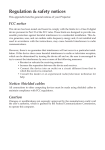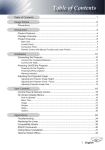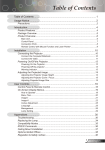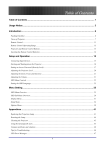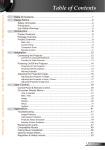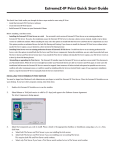Download EP770 - Optoma USA
Transcript
Table of Contents Table of Contents ....................................................................................... 1 Usage Notice .............................................................................................. 2 Precautions ..........................................................................................................2 Introduction ................................................................................................ 4 Product Features ..................................................................................................4 Package Overview ...............................................................................................5 Product Overview .................................................................................................6 Main Unit ........................................................................................................................6 Control Panel .................................................................................................................7 Connection Ports ...........................................................................................................8 Remote Control ..............................................................................................................9 Installation ................................................................................................ 10 Connecting the Projector ....................................................................................10 Powering On/Off the Projector ...........................................................................11 Powering On the Projector ........................................................................................... 11 Powering Off the projector ...........................................................................................12 Warning Indicator .........................................................................................................12 Adjusting the Projected Image ...........................................................................13 Adjusting the Projector Image Height ..........................................................................13 Adjusting the Projector Zoom / Focus ..........................................................................14 Adjusting Projected Image Size ...................................................................................14 User Controls ........................................................................................... 15 Control Panel & Remote Control ........................................................................15 On-Screen Display Menus .................................................................................18 How to operate ............................................................................................................18 Language .....................................................................................................................19 Image-I ........................................................................................................................20 Image-II (Computer Mode)...........................................................................................22 Image-II (Video Mode) .................................................................................................24 Audio ............................................................................................................................26 Management ................................................................................................................27 Lamp Setting ...............................................................................................................29 Appendices ............................................................................................... 30 Troubleshooting ..................................................................................................30 Replacing the lamp .............................................................................................34 Compatibility Modes ...........................................................................................35 Ceiling Mount Installation ...................................................................................36 RS232 Commands .............................................................................................37 Optoma Global Offices .......................................................................................38 1 ... English Usage Notice Precautions Follow all warnings, precautions and maintenance as recommended in this user’s guide to maximize the life of your unit. Warning- Do not look into the projector’s lens when the lamp is on. The bright light may hurt your eyes. Warning- To reduce the risk of fire or electric shock, do not expose this projector to rain or moisture. Warning- Please do not open or disassemble the projector as this may cause electric shock. Warning- When replacing the lamp, please allow unit to cool down, and follow all replacement instructions. See page 34. Warning- This projector will detect the life of the lamp itself. Please be sure to change the lamp when it shows warning messages. Warning- Reset the “Lamp Reset” function from the on-screen display “Lamp Setting” menu after replacing the lamp module (refer to page 29). Warning- When switching the projector off, please ensure the cooling cycle has been completed before disconnecting power. Warning- Turn on the projector first and then the signal sources. Warning- Do not use lens cap when projector is in operation. Warning- When the lamp reaches the end of its life, it will burn out and may make a loud popping sound. If this happens, the projector will not turn back on until the lamp module has been replaced. To replace the lamp, follow the procedures listed under “Replacing the Lamp”. English ... 2 Usage Notice Do: Turn off the product before cleaning. Use a soft cloth moistened with mild detergent to clean the display housing. Disconnect the power plug from AC outlet if the product is not being used for a long period of time. Don’t: Block the slots and openings on the unit provided for ventilation. Use abrasive cleaners, waxes or solvents to clean the unit. Use under the following conditions: - In extremely hot, cold or humid environments. - In areas susceptible to excessive dust and dirt. - Near any appliance that generates a strong magnetic field. - Place in direct sunlight. 3 ... English Introduction Product Features Congratulations and Thank You for choosing Optoma projectors. This product is a XGA single chip 0.7” DLP® projector. Features include: True XGA, 1024 x 768 addressable pixels Single chip DLP® technology NTSC/NTSC4.43/PAL/PAL-M/PAL-N/SECAM and HDTV compatible (480i/p, 576i/p, 720p, 1080i) High-tech DVI connection for digital signal with HDCP function and supports 480p, 576p, 720p and 1080i Full function remote control User friendly multilingual on screen display menu Advanced digital keystone correction and high quality full screen image re-scaling User friendly control panel SXGA+, SXGA compression and VGA, SVGA re-sizing Mac compatible English ... 4 Introduction Package Overview This projector comes with all the items shown below. Check to make sure your unit is complete. Contact your dealer immediately if anything is missing. Projector with lens cap Power Cord 1.8m VGA Cable 1.8m Composite Video Cable 2.0m Remote Control 2 x Battery Carrying Case (Optional Accessory) SCART RGB/S-Video Adaptor (Optional Accessory) Documents : User’s Guide Quick Start Card Warranty Card WEEE Card 5 ... English Introduction Product Overview Main Unit 2 1 3 6 4 5 9 7 8 English ... 6 1. 2. 3. 4. 5. 6. 7. 8. 9. Focus Ring Zoom Ring Zoom Lens Elevator Button Elevator Foot Remote Control Receiver Connection Ports Power Socket Control Panel Introduction Control Panel 10 4 9 3 5 8 1. 2. 3. 4. 5. 6. 7. 8. 9. 10. 10 6 7 2 1 Temp Indicator LED Lamp Indicator LED Power Indicator LED Power/Standby Source Auto Image Menu (On/Off) Four Directional Select Keys Enter Keystone Correction 7 ... English Introduction Connection Ports 5 9 1. 2. 3. 4. 5. 6. 7. 8. 9. English ... 8 4 3 2 8 7 1 6 DVI-D Input Connector (for Digital signal with HDCP function) PC Analog Signal SCART RGB/HDTV/Component Video Input Connector Monitor Loop-through Output Connector USB Input Connector RS232 Input Connector S-Video Input Connector Composite Video Input Connector Audio Input Connector KensingtonTM Lock Port Introduction Remote Control 1 2 6 3 7 4 8 9 5 10 11 12 13 14 16 1. 2. 3. 4. 5. 6. 7. 8. 9. 10. 11. Transmit Indicator Light Power Re-Sync Volume ( + / - ) Reset Hide Freeze Page Up / Page Down Keystone Correction Menu Four Directional Select Keys 15 12. 13. 14. 15. 16. Enter DVI-D Source VGA Source S-Video Source Composite Video Source 9 ... English Installation Connecting the Projector 1 USB RGB DVI RS232 4 9 5 2 8 DVD Player, Settop Box, HDTV receiver 7 Video Output 3 6 S-Video Output 1. ....................................................................................................................Power Cord 2. ..................................................................................................................... VGA Cable 3. ............................................................................................... Composite Video Cable 4. .............................................................SCART RGB Adaptor (Optional Accessory) 5. .......................................................... Audio Cable Jack/Jack (Optional Accessory) 6. ..........................................................................S-Video Cable (Optional Accessory) 7. .................... D-Sub to RCA Cable for HDTV/Component (Optional Accessory) 8. ....................................................................DVI to DVI Cable (Optional Accessory) 9. ............................................................................. RS232 Cable (Optional Accessory) To ensure the projector works well with your computer, please set English ... 10 the display mode of your graphic card less than or equal to 1024 X 768 resolution. Make sure the timing of the display mode is compatible with the projector. Refer to the “Compatibility Modes” section on page 35. Installation Powering On/Off the Projector Powering On the Projector Quick Menu 1. Remove the lens cap. 2. Ensure that the power cord and signal cable are securely connected. The Power LED will flash green. 3. Turn on the lamp by pressing “Power/Standby” button on the control panel. And the Power LED will turn green. The first time you use the projector, you can select your preferred language from quick menu after the startup screen display. 4. Turn on your source (computer, notebook, video player, etc.). The projector will detect your source automatically. If the screen displays “No Signal”, please make sure the signal cables are securely connected. If you connect multiple sources at the same time, use the “Source” button on the control panel to switch. 1 Power/Standby Turn on the projector first and then the signal sources. 11 ... English Installation Powering Off the Projector 1. Press the “Power/Standby” button to turn off the projector lamp, you will see a message “Power off the lamp? Picture Mute” displayed on the projector’s screen. Press the “Power/Standby” button again to confirm, otherwise the message will disappear after 5 seconds. Please note that if the key is pressed instead, the projector will enter the “Picture Mute” mode and no image will be displayed. To exit the “Picture Mute” mode, press the “Power/Standby” button again. 2. The cooling fans continue to operate for about 60 seconds for cooling cycle and the Power LED will turn green. When the Power LED begins flashing, the projector has entered standby mode. If you wish to turn the projector back on, you must wait until the projector has completed the cooling cycle and has entered standby mode. Once in standby mode, simply press “Power/Standby” button to restart the projector. 3. Disconnect the power cord from the electrical outlet and the projector. 4. Do not turn on the projector immediately following a power off procedure. Warning Indicator When the “LAMP” indicator lights solid red, the projector will automatically shut itself down. Please contact your local reseller or service center. When the “TEMP” indicator lights solid red for about 20 seconds, it indicates the projector has been overheated. You will see a message “Projector Overheated. Lamp will automatically turn off soon.” on the on-screen display. The projector will automatically shut itself down. Under normal conditions, the projector can be switched on again after it has cooled down. If the problem persists, you should contact your local dealer or our service center. English ... 12 When the “TEMP” indicator flashes red for about 10 seconds, you will see a message “Fan failure. Lamp will automatically turn off soon.” on the on-screen display. Please contact your local dealer or our service center. Installation Adjusting the Projected Image Adjusting the Projector Image Height The projector is equipped with an elevator foot for adjusting the image height. To raise the image: 1. Press the elevator button . 2. Raise the image to the desired height angle , then release the button to lock the elevator foot into position. 3. Use to fine-tune the display angle. To lower the image: 1. Press the elevator button. 2. Lower the image, then release the button to lock the elevator foot into position. 3. Use to fine-tune the display angle. 1 Elevator Button 2 3 Elevator Foot Tilt Adjusting Feet 13 ... English Installation Adjusting the Projector Zoom / Focus You may turn the zoom ring to zoom in or out. To focus the image, rotate the focus ring until the image is clear. The projector will focus at distances from 3.9 to 32.8 feet (1.2 to 10.0 meters). Zoom Ring Focus Ring Adjusting Projection Image Size 246.1"(625.0cm) 196.9"(500.0cm) 205.1" (520.8cm) 172.2"(437.5cm) 164.0" (416.7cm) 123.0"(312.5cm) 143.5" (364.6cm) 73.8"(187.5cm) 102.5" (260.4cm) 29.5" (75.0cm) 61.5" (156.3cm) 24.6" (62.5cm) 3.94'(1.2m) 9.84'(3.0m) 16.40'(5.0m) 22.97'(7.0m) 26.25'(8.0m) 32.81'(10.0m) Screen (Diagonal) Screen Size Max. 29.5"(75.0cm) 73.8"(187.5cm) 123.0"(312.5cm) 172.2"(437.5cm) 196.9"(500.0cm) Min. 24.6"(62.5cm) 61.5"(156.3cm) 102.5"(260.4cm) 143.5"(364.6cm) 164.0"(416.7cm) 205.1"(520.8cm) Max.(WxH) 23.60" x 17.70" (60.0 x 45.0cm) 59.04" x 44.28" 98.40" x 73.80" 137.76" x 103.32" 157.52" x 118.14" (150.0 x 112.5cm) (250.0 x 187.5cm) (350.0 x 262.5cm) (400.0 x 300.0cm) 196.88" x 147.66" (500.0 x 375.0cm) Min.(WxH) 19.68" x 14.76" (50.0 x 37.5cm) 49.20" x 36.90" (125.0 x 93.8cm) 164.08" x 123.06" (416.6 x 312.5cm) 3.94'(1.2m) 9.84'(3.0m) Distance English ... 14 82.00" x 61.50" 114.80" x 86.10" 131.20" x 98.40" (208.3 x 156.2cm) (291.7 x 218.8cm) (333.4 x 250.0cm) This graph is for user’s reference only. 16.40'(5.0m) 22.97'(7.0m) 26.25'(8.0m) 246.1"(625.0cm) 32.81'(10.0m) User Controls Control Panel & Remote Control There are two ways for you to control the functions: Remote Control and Control Panel. Control Panel Remote Control Using the Control Panel Power/Standby Refer to the “Power On/Off the Projector” section on pages 1112. Source Press “Source” to choose RGB, Component-p, Component-i, SVideo, Composite Video and HDTV sources. Menu Press “Menu” to launch the on screen display (OSD) menu. To exit OSD, press “Menu” again. Keystone /Keystone Adjusts image distortion caused by tilting the projector (±16 degrees). Four Directional Select Keys Use selection. to select items or make adjustments to your Enter Confirm your selection of items. Auto Image Automatically synchronizes the projector to the input source. 15 ... English User Controls Using the Remote Control Power/Standby Refer to the “Power On/Off the Projector” section on pages 1112. Re-Sync Automatically synchronizes the projector to the input source. Volume + / - (Vol+/Vol-) Increases/decreases speaker volume. Reset Changes the adjustments and settings to the factory default value. Hide Press “Hide” to hide image, press again to restore display of the image. Keystone / Adjusts image distortion caused by tilting the projector (±16 degrees). Page Up (Computer mode only) Use this button to page up. This function is only available when the projector is connected to a computer via an USB cable. Page Down (Computer mode only) Use this button to page down. This function is only available when the projector is connected to a computer via an USB cable. Freeze Press “Freeze” to pause the screen image. Four Directional Select Keys Use selection. to select items or make adjustments to your Menu Press “Menu” to launch the on screen display menu. To exit OSD, press “Menu” again. Enter Confirm your selection of items. VGA Press “VGA” to choose Analog RGB, component and SCART /HDTV source. S-Video English ... 16 Press “S-Video” to choose S-Video source. User Controls Composite Press “composite” to choose Composite video source. DVI-D Press “DVI-D” to choose DVI-D connector. 17 ... English User Controls On Screen Display Menus The Projector has multilingual On Screen Display menus that allow you to make image adjustments and change a variety of settings. The projector will automatically detect the source. How to operate 1. To open the OSD menu, press “Menu” on the Remote Control or Control Panel. 2. When OSD is displayed, use keys to select any item in the main menu. While making a selection on a particular page, press 3. Use tings by “Enter ” key to enter sub menu. keys to select the desired item and adjust the setkey. 4. Select the next item to be adjusted in the sub menu and adjust as described above. 5. Press “Menu” to confirm, and the screen will return to the main menu. 6. To exit, press “Menu” again. The OSD menu will close and the projector will automatically save the new settings. Main Menu Sub Menu English ... 18 Setting User Controls Computer / Video Mode Language Language Choose the multilingual OSD menu. Use the your preferred language. Press or key to select “Enter” to finalize the selection. 19 ... English User Controls Computer / Video Mode Image-I Display Mode There are many factory presets optimized for various types of images. PC : For computer or notebook. Movie : For home theater. Game : For game. sRGB : For PC standard color. User : Memorize user’s settings. Brightness Adjust the brightness of the image. Press the Press the Contrast to darken image. to lighten the image. The contrast controls the degree of difference between the lightest and darkest parts of the picture. Adjusting the contrast changes the amount of black and white in the image. Press the to decrease the contrast. Press the to increase the contrast. Keystone (Keystone Correction) Adjust image distortion caused by tilting projector. (±16 degrees) Color Press “Enter” to adjust the red, green and blue colors. English ... 20 User Controls Computer / Video Mode Image-I White Peaking Use the white peaking control to set the white peaking level of DMD chip. 0 stands for minimal peaking, and 10 stands for maximum peaking. If you prefer a stronger image, adjust towards the maximum setting. For a smooth and more natural image, adjust towards the minimum setting. Color Temp. Adjust the color temperature. At higher temperature, the screen looks colder; at lower temperature, the screen looks warmer. 21 ... English User Controls Computer Mode Image-II (Computer Mode) Frequency “Frequency” changes the display data frequency to match the frequency of your computer’s graphic card. If you experience a vertical flickering bar, use this function to make an adjustment. Tracking “Tracking” synchronizes the signal timing of the display with the graphic card. If you experience an unstable or flickering image, use this function to correct it. H.Position (Horizontal Position) Press the to move the image left. Press the to move the image right. V. Position (Vertical Position) Press the Press the Degamma to move the image down. to move the image up. This allows you to choose a degamma table that has been fine-tuned to bring out the best image quality for the input. Aspect Ratio Use this function to choose your desired aspect ratio. 4:3 : The input source will be scaled to fit the projection screen. 16:9 : The input source will be scaled to fit the width of the screen. English ... 22 Video Mode Image-II (Computer Mode) Window: When a 4:3 image is bigger than a 16:9 screen, select the “Window” mode to fit the image onto the screen without changing the projection distance. Original Pixel Window 16:9 Image Position Adjust the image position to up or down, when you select the aspect ratio to 16:9. Press the Press the to move the image down. to move the image up. 23 ... English User Controls Computer Mode Image-II (Video Mode) Degamma This allows you to choose a degamma table that has been fine-tuned to bring out the best image quality for the input. Saturation Adjusts a video image from black and white to fully saturated color. Press the to decrease the amount of color in the image. Press the to increase the amount of color in the image. Tint Adjusts the color balance of red and green. Press the Press the Sharpness to increase the amount of green in the image. to increase the amount of red in the image. Adjusts the sharpness of the image. “Saturation”, “Tint” and “Sharpness” function is not supported under DVI-D mode. Press the to decrease the sharpness. Press the to increase the sharpness. Aspect Ratio Use this function to choose your desired aspect ratio. 4:3 : The input source will be scaled to fit the projection screen. 16:9 : The input source will be scaled to fit the width of the screen. Window: When a 4:3 image is bigger than a 16:9 screen, select the “Window” mode to fit the image onto the screen without changing the projection distance. English ... 24 User Controls Video Mode Image-II (Video Mode) Original Pixel Window 16:9 Image Position Adjust the image position to up or down, when you select the aspect ratio to 16:9. Press the Press the to move the image down. to move the image up. 25 ... English User Controls Computer / Video Mode Audio Volume Press the Press the Mute to decrease the volume. to increase the volume. Choose the left icon to turn mute on. Choose the right icon to turn mute off. English ... 26 User Controls Computer / Video Mode Management Menu Location Choose the Menu location on the display screen. Projection Front-Desktop The factory default setting. Rear-Desktop When you select this function, the projector reverses the image so you can project behind a translucent screen. Front-Ceiling When you select this function, the projector turns the image upside down for ceiling-mounted projection. Rear-Ceiling When you select this function, the projector reverses and turns the image upside down at same time. You can project from behind a translucent screen with ceiling mounted projection. Signal Type Select signal type RGB or Video sources. Source Lock When source lock is turned off, the projector will search for other signals if the current input signal is lost. When source lock is turned on, it will continue to search for the “lost signal” after “Source “ is pressed. 27 ... English User Controls Computer / Video Mode Management High Altitude Choose “ON” to turn on High Altitude mode. Operates the fans at full speed continuously to allow for proper high altitude cooling of the projector. Reset Choose “Yes” to return the display parameters on all menus to the factory default settings. Zoom Press the Press the English ... 28 to reduce the size of an image. to magnify an image on the projection screen. User Controls Computer / Video Mode Lamp Setting Lamp Hour Displays the lamp’s elapsed operating time (in hours). Lamp Reset Turns the lamp hour counter to 0 hours. Lamp Reminder Choose this function to show or to hide the warning message when the changing lamp message is displayed. The message will show up 30 hours before end of life. STD Mode Choose “On” to dim the projector lamp which will lower power consumption and extend the lamp life by up to 130%. Choose ”Off” to return BRIGHT mode. Auto Power Off (min) Sets the interval of power-off of the system, if there is no signal input. (In minutes) 29 ... English Appendices Troubleshooting If you experience trouble with the projector, refer to the following information. If the problem persists, please contact your local reseller or service center. Problem: No image appears on screen. Ensure all the cables and power connections are correctly and securely connected as described in the “Installation” section. Ensure the pins of connectors are not crooked or broken. Check if the projection lamp has been securely installed. Please refer to the “Replacing the lamp” section. Make sure you have removed the lens cap and the projector is switched on. Ensure that the “Hide” feature is not enabled. Problem: Partial, scrolling or incorrectly displayed image. Press the “Re-Sync” button on the Remote Control or press the “Auto Image” button on the Control Panel. If you use a PC: If the resolution of your computer is higher than 1024 x 768. Follow the steps outlined below to reset the resolution. For Windows 3.x: 1. In the Windows Program Manager, click the “Windows Setup” icon in the Main group. 2. Verify that your display resolution setting is less than or equal to 1024 x 768. For Windows 95,98,2000,XP: 1. Open “My Computer” icon, the “Control Panel” folder, and then double click on the “Display” icon. 2. Select the “Setting” tab. 3. In the “Desktop Area” you will find the resolution setting. Verify that the resolution setting is less than or equal to 1024 x 768 resolution. If the projector is still not projecting the whole image, you will also need to change the monitor display you are using. Refer to the following steps. English ... 30 4. Follow the above steps 1-2. Click on the “Advanced Properties” button. 5. Select the “Change” button under the “Monitor” tab. Appendices 6. Click on “Show all devices”. Then select “Standard monitor types” under the “Manufacturers” box ; choose the resolution mode you need under the “Models” box. 7. Verify that the resolution setting of the monitor display is less than or equal to 1024 x 768. If you are using a Notebook PC: 1. You are required to implement the above steps of resolution setting of the computer first. 2. Switch the Notebook PC display to the “external display only” or “CRT only” mode. If you experience difficulty in changing resolutions or your monitor freezes, restart all the equipment and the projector. Problem: The screen of the Notebook or PowerBook computer is not displaying your presentation. If you are using a Notebook PC: Some Notebook PCs may deactivate their screens when a second display device is in use. Refer to your computer’s documentation for information on how to reactivate the monitor display. If you are using an Apple PowerBook: In Control Panels, open the PowerBook Display to select Video Mirroring “On”. Problem: Image is unstable or flickering Use “Tracking” to correct it. Refer to page 22. Change the monitor color setting from your computer. Problem: Image has vertical flickering bar Use “Frequency” to make an adjustment. Refer to page 22. Check and reconfigure the display mode of your graphic card to make it compatible with the product. Refer to page 30. Problem: Image is out of focus Adjusts the Focus Ring on the projector lens. Refer to page 14. Make sure the projection screen is between the required distance 3.9 to 32.8 feet (1.2 to 10.0 meters) from the projector. 31 ... English Appendices Problem: The image is stretched when displaying 16:9 DVD. The projector automatically detects 16:9 DVD and adjusts the aspect ratio by digitizing to full screen with 4:3 default setting. If the image is still stretched, you will also need to adjust the aspect ratio by referring to the following: Please select 4:3 aspect ratio type on your DVD player if you are playing a 16:9 DVD. If you cannot select 4:3 aspect ratio type on your DVD player, please select 4:3 aspect ratio in the on screen menu. Problem: Image is reversed. Select “Management” from the OSD and adjust the projection direction. See page 27. Problem: Lamp burns out or makes a popping sound When the lamp reaches its end of life, it will burn out and may make a loud popping sound. If this happens, the projector will not turn on until the lamp module has been replaced. To replace the lamp, follow the procedures in the “Replacing the Lamp”. See page 34. Problem: LED lighting message Message Standby State (Input power cord) Power LED (Green) Temp-LED Flashing Lamp lighting Power on Power off (Cooling) Error (Lamp fail) Error (Thermal fail) Error (Fan fail) Error (Over Temp.) Error (Lamp Breakdown) English ... 32 Flashing Lamp-LED Appendices Problem: Message Reminders “Lamp is approaching the end of its useful life in full power opera tion. Replacement Suggested!” will be shown about 10 seconds, when lamp is nearing end of life. “Projector Overheated. Lamp will automatically turn off soon.” will be shown when the system temperature is too high. “Fan failure. Lamp will automatically turn off soon.” will be shown when the fan is out of order. 33 ... English Appendices Replacing the lamp The projector will detect the lamp life itself. It will show you a warning message “Lamp is approaching the end of its useful life in full power operation. Replacement Suggested!” When you see this message, changing the lamp as soon as possible. Make sure the projector has been cooled down for at least 30 minutes before changing the lamp. Warning: Lamp compartment is hot! Allow it to cool down before changing lamp! 1 3 2 4 Lamp Changing Procedure: Warning: To reduce the risk of personal injury, do not drop the lamp module or touch the lamp bulb. The bulb may shatter and cause injury if it is dropped. English ... 34 1. Switch off the power to the projector by pressing the Power button. 2. Allow the projector to cool down at least 30 minutes. 3. Disconnect the power cord. 4. Use a screwdriver to remove the screw from the cover. 5. Push up and remove the cover. 6. Remove the 2 screws from the lamp module. 7. Pull out the lamp module. To replace the lamp module, reverse the previous steps. Appendices Compatibility Modes Remark : “*” compressed computer image. Mode Resolution VESA VGA VESA VGA (ANALOG) (DIGITAL) V.Frequency (Hz) H.Frequency (kHz) V.Frequency (Hz) H.Frequency (kHz) 640 x 350 70 31.5 70 31.5 640 x 350 85 37.9 85 37.9 VESA VGA 640 x 400 85 37.9 -- -- VESA VGA 640 x 480 60 31.5 60 31.5 VESA VGA 640 x 480 72 37.9 72 37.9 VESA VGA 640 x 480 75 37.5 75 37.5 VESA VGA 640 x 480 85 43.3 85 43.3 VESA VGA 720 x 400 70 31.5 70 31.5 VESA VGA 720 x 400 85 37.9 85 37.9 SVGA 800 x 600 56 35.2 56 35.2 SVGA 800 x 600 60 37.9 60 37.9 SVGA 800 x 600 72 48.1 72 48.1 SVGA 800 x 600 75 46.9 75 46.9 SVGA 800 x 600 85 53.7 85 53.7 VESA XGA 1024 x 768 60 48.4 60 48.4 VESA XGA 1024 x 768 70 56.5 70 56.5 VESA XGA 1024 x 768 75 60.0 75 60.0 VESA XGA 1024 x 768 85 68.7 85 68.7 * VESA SXGA 1152 x 864 70 63.8 - - * VESA SXGA 1152 x 864 75 67.5 - - * VESA SXGA 1152 x 864 85 77.1 - - * VESA SXGA 1280 x 1024 60 63.98 60 63.98 * VESA SXGA 1280 x 1024 75 79.98 - - * VESA SXGA+ 1400 x 1050 60 63.98 - - MAC LC 13" 640 x 480 66.66 34.98 - - MAC II 13" 640 x 480 66.68 35 - - MAC 16" 832 x 624 74.55 49.725 - - MAC 19" 1024 x 768 75 60.24 - - * MAC 1152 x 870 75.06 68.68 - - MAC G4 640 x 480 60 31.35 - - i Mac DV 1024 x 768 75 60 - - * i Mac DV 1152 x 870 75 68.49 - - * i Mac DV 1280 x 960 75 75 - - 35 ... English Appendices Ceiling Mount Installation 1. To prevent damaging your projector, please use the ceiling mount package for installation. 2. If you wish to use a third party ceiling mount kit, please ensure the screws used to attached a mount to the projector met the following specifications: 110.00 50.50 72.31 104.31 232.31 235.01 55.00 82.15 50.15 Please note that damage resulting from incorrect installation will invalidate the warranty. Screw type: M3 Maximum screw length: 10mm Minimum screw length: 8mm English ... 36 67.00 Max. / Min. 602.5 / 402.50 119.00 49.83 Warning: 1. If you buy the ceiling mount from other company, please ensure that there is at least 10cm distance between the bottom cover of the projector and the ceiling. 2. Avoid placing the projector near sources of heat such air-conditioning units and heaters otherwise it may overheat and shut down automatically. 3. Ceiling mounting shall be mounting on metal or concrete. Appendices RS232 Commands VGA-In Connector RS232 Connector 3 1 2 Pin no. Name I/O (From Projector Side 1 TXD OUT 2 RXD IN 3 GND __ 5 4 10 9 8 15 14 13 Pin no. 3 2 7 12 1 6 11 Spec. 1 R(RED)/Cr 2 G(GREEN)/Y 3 B(BLUE)/Cb 4 NC 5 GND 6 GND 7 GND 8 GND 9 DDC 5V 10 HOT_DET 11 NC 12 DDC Date 13 HS/CS 14 VS 15 DDC Clock 37 ... English Appendices Optoma Global Offices For service or support please contact your local office. USA 715 Sycamore Drive Milpitas, CA 95035, USA www.optomausa.com Tel : 408-383-3700 Fax: 408-383-3702 Service : [email protected] Canada 5630 Kennedy Road, Mississauga, ON, L4Z 2A9 Tel : 905-882-4228 Fax: 905-882-4229 www.optoma.com Europe 42 Caxton Way, The Watford Business Park Watford, Hertfordshire, WD18 8QZ, UK Tel : +44 (0) 1923 691 800 Fax: +44 (0) 1923 691 888 www.optomaeurope.com Service Tel : +44 (0)1923 691865 Service : [email protected] Taiwan 5F., No. 108, Minchiuan Rd. Shindian City, Taipei Taiwan 231, R.O.C. Service : [email protected] Tel : +886-2-2218-2360 Fax: +886-2-2218-2313 www.optoma.com.tw asia.optoma.com Hong Kong Rm. 2507, 25/F., China United Plaza, No. 1008 Tai Nan West St., Kowloon, H.K. Tel : +852-2396-8968 Fax: +852-2370-1222 www.optoma.com.hk China 5F, No. 1205, Kaixuan Rd., Changning District Shanghai, 200052, China Latin America 715 Sycamore Drive Milpitas, CA 95035, USA www.optoma.com.br English ... 38 Tel : +86-21-62947376 Fax: +86-21-62947375 www.optoma.com.cn Tel : 408-383-3700 Fax: 408-383-3702 www.optoma.com.mx Regulation & safety notices This appendix lists the general notices of your Projector. FCC notice This device has been tested and found to comply with the limits for a Class B digital device pursuant to Part 15 of the FCC rules. These limits are designed to provide reasonable protection against harmful interference in a residential installation. This device generates, uses, and can radiate radio frequency energy and, if not installed and used in accordance with the instructions, may cause harmful interference to radio communications. However, there is no guarantee that interference will not occur in a particular installation. If this device does cause harmful interference to radio or television reception, which can be determined by turning the device off and on, the user is encouraged to try to correct the interference by one or more of the following measures: • Reorient or relocate the receiving antenna. • Increase the separation between the device and receiver. • Connect the device into an outlet on a circuit different from that to which the receiver is connected. • Consult the dealer or an experienced radio/television technician for help. Notice: Shielded cables All connections to other computing devices must be made using shielded cables to maintain compliance with FCC regulations. Caution Changes or modifications not expressly approved by the manufacturer could void the user’s authority, which is granted by the Federal Communications Commission, to operate this computer. i ... English Operation conditions This device complies with Part 15 of the FCC Rules. Operation is subject to the following two conditions: 1.this device may not cause harmful interference, and 2.this device must accept any interference received, including interference that may cause undesired operation. Notice: Canadian users This Class B digital apparatus complies with Canadian ICES-003. Remarque à l’intention des utilisateurs canadiens Cet appareil numerique de la classe B est conforme a la norme NMB-003 du Canada. Declaration of Conformity for EU countries • EMC Directive 89/336/EEC (including amendments) • Low Voltage Directive 73/23/EEC (amended by 93/68/ EEC) • R & TTE Directive 1999/EC (if product has RF function) English ... ii









































